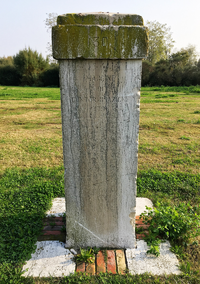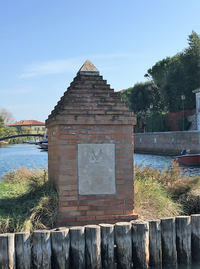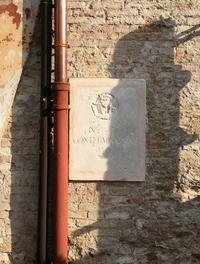Boundary Marker
This article contains information about a typical boundary marker. For a list of border markers, see Boundary Markers.
A boundary marker (cippi in Italian) is a marker made typically of stone or brick. The markers were placed in 1791 to denote the boundaries of the Venetian lagoon at the time (see Boundary Markers). An individual marker acted as one point on the whole boundary to help delineate one side of the boundary from the other. Because of their age, a marker’s physical condition has a very wide range.
Marker Dimension/Materials
There are two main kinds of markers that had been placed to outline the border of the Venetian Republic's claim to the lagoon: Stone Markers and Brick Markers.
Stone Markers
Stone markers are the more common of the two types of markers. They are about 130 cm in height, 50 cm wide, and 50 cm deep. Stone markers are made of a white stone called Istria Stone. A stone marker is comprised of a main face, a secondary face, and a shorter spire. The main face is on the bottom of the marker and is the tallest, yet narrowest, of the faces. The secondary face, above the main face, is wider than the main face but significantly shorter. Out of the secondary face grows the spire, which is a square pyramid using the secondary faces as its base. The spire on a stone marker is very short, measuring around 15 cm.
Brick Markers
Brick markers are less common than marble markers. They are about 100 cm in height, 100 cm in width and 100 cm deep. Brick markers are comprised mainly of brick, with one face partly consisting of marble. A brick marker is made up by main faces and spires. The main faces start from the ground or a pedestal and stretch up to the beginning of the spire. On the front face of the marker, there is part of the face that is covered in marble, where the inscription will be located. The spire is located above the main faces. Its base extends outside of the main faces by 5 cm. The spire is typically about 80 cm tall.
Marker Plaques
A small amount of markers have been replaced with plaques after the industrialization of the marker's location. Made of Istria stone, the plaques are typically 70 cm in height and 70 cm in width.
Each marker has an inscription on it which denotes its number in the sequence of markers. This inscription typically says "MARGINE DI CONTERMINAZIONE | 1791" and then the number of the marker.
Marker Condition
Because they were placed over 225 years ago, an individual marker may have a wide range of erosion, biological growth, and overgrowth. A marker may also have surface cracking and/or structural cracking. Though treated as public art, many markers are either inaccessible due to their location (inside confines of airport or private property, hard to find or access due to terrain) or have been demolished or destroyed.


